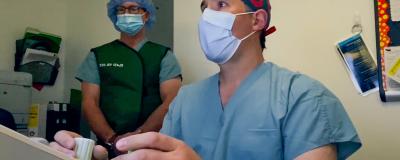A male patient in his 60s was found to have an unruptured anterior communicating artery (ACom) aneurysm after a CT angiography (CTA) of the head and neck was performed for unrelated reasons. He does not have a family history of aneurysms.
Presentation and examination
The CTA demonstrated an unruptured, wide-necked 9.5-mm-by- 7.5-mm-by-4.7-mm ACom aneurysm.
Several options were discussed with the patient about how to treat his aneurysm, including observation with serial imaging, surgical clipping or endovascular treatment. Given his age and the size and location of the aneurysm, I recommended treating it rather than observation.
When feasible, I prefer endovascular treatment of aneurysms instead of craniotomy and surgical clipping. For wide-necked aneurysms such as this one, endovascular options may include stent-assisted coil embolization or WEB embolization.
Treatment
Ultrasound was used to visualize the right radial artery. After confirming the artery was of sufficient caliber for a radial approach to the aneurysm, the artery was accessed using a micropuncture needle. A 7 French slender sheath was inserted into the radial artery and a radial cocktail, including nitroglycerin, verapamil and heparin, was slowly infused through the sheath.
Accessing from the right radial artery, we advanced a Rist 079 Guide catheter over a 5 French SIM 2 catheter into the left internal carotid artery. Once the Rist catheter was in its desired location, a 5 French intermediate catheter was advanced over a 017 microcatheter and a microwire into the intracranial internal carotid artery. The microcatheter was advanced into the aneurysm and a 7mm-by-4mm SL WEB device was advanced through the microcatheter. This was slowly deployed into the aneurysm until it was felt to sit nicely within the aneurysm, at which point it was permanently detached from the delivery wire.
A final angiogram was performed showing excellent embolization of the aneurysm with immediate stasis within the device.
At this point, the guide catheter and sheath were removed and the radial artery was closed using the transradial band.


About the Rist Guide Catheter from Medtronic
The Rist catheter helps surgeons access the neurovasculature through the radial pathway. It provides both distal navigability and proximal stability matched to the radial trajectory, and it is engineered to effortlessly navigate through tough acute bends in the radial pathway.
Outcome
The aneurysm was successfully treated with the WEB embolization system via a right-radial approach using the Rist catheter.
Analysis
Radial access
Historically, the endovascular approach for the treatment of cerebral aneurysms or other cerebral pathology has been done via the femoral artery. As we learn more from our colleagues in cardiology about ways to access the heart, we are gaining more experience with radial access, which ultimately provides several benefits to patients.
The risk in treating most cerebral aneurysms can be quite low, and the literature puts it around 2 to 4% for all kinds of major complications. These risks include access site complications. When approaching an aneurysm through the femoral artery, the complications may include retroperitoneal hematomas and pseudoaneurysms. While the risk of developing these complications is low, if they develop and go unrecognized, that can be disastrous for patients and outcomes may include death. While accessing the cerebrovasculature through the radial artery is not risk-free, the complications when compared to femoral access are significantly lower, and the risk of life-threatening complications is essentially eliminated.
From a comfort standpoint, patients mostly prefer radial access. If we go through the femoral artery, patients have to lay flat for a minimum of two hours, providing the closure device works. If the closure device doesn’t work, the patient could be lying flat for up to six hours. Additionally, given the sensitivity of the groin area, patients would rather have access in the wrist, which is akin to the feeling of getting an IV. They can sit up and walk around immediately with the transradial band in place, increasing their comfort greatly. This also generally allows them to eat sooner after the procedure, since we avoid giving food to patients who are lying flat.
Rist catheter
Since most neurosurgeons have typically accessed aneurysms through the femoral artery, catheters were designed with that functionality in mind. The Rist catheter is novel since it was designed to start from the radial artery. The turns are different with this approach; there are different points as we thread the catheter up to the brain where the catheter needs specific structural support, which the Rist catheter provides. This enables us to more reliably perform these types of neurological interventions.
One of the roadblocks that prevents widespread adoption of the radial approach is physician training. Until a few years ago, almost all aneurysm treatments were started with femoral access. Thus, there’s not only a certain comfort level with that approach, but the catheters were designed to start in the leg. Every so often, surgeons would get a complex case where the femoral approach was not feasible, which forced them to go through the wrist. Therefore, many neurointerventionalists have long associated radial access with problematic cases rather than straightforward ones.
I’ve been an early adopter of this technology and performed the first neurosurgical procedure using the Rist catheter in the world. As more surgeons adopt the radial approach combined with the utilization of radial-specific technology, I believe it will reduce the complications for the treatment of cerebrovascular pathology while providing patients across the country with greater satisfaction.

